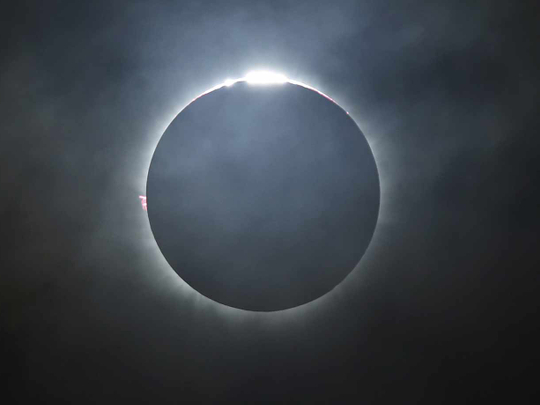
Last week I experienced the most extraordinary three minutes of cosmic connection I have ever been privileged to. Indeed, I travelled to an Indonesian island (Ternate) with my wife and a friend to watch my first total solar eclipse.
As you may know, I am a professor of physics and astronomy; thus, in my academic life I have described and explained this phenomenon to thousands of students. But believe me, nothing prepares you for the sight of the moon creeping up on the sun, slowly switching it off, to a moment when the world changes around you.
I had often read about “eclipse chasers”, people who go from one corner of the world to another just to watch a solar eclipse, which can last seven minutes at most (in our case it lasted about three minutes). I realised that the experience must be addictive when we boarded the flight from Jakarta to Ternate, and the travellers were obviously from various parts of the world. Some had seen a solar eclipse somewhere else before; others (like me) were jumping on the opportunity to see it for the first time. Indeed, one must not wait for a total eclipse to come to where one lives, for that takes on average 375 years. If one can afford it, one must travel to the narrow region of totality, where the moon covers the sun for a few minutes somewhere on Earth once or twice a year, roughly.
The build-up to the big moment was itself like a premonitory experience — you feel that something big is about to happen. Wearing eclipse glasses (to protect one’s eyes from the sun’s ultra-violet rays), you see the moon devouring the big sun, despite being 400 times smaller in diameter. But it’s the fact that the moon is also 400 closer to Earth than the Sun that allows for this magnificent event and spectacle. And not only is Earth the only place in the solar system where such a perfect match occurs; with the moon having been much closer to us and slowly receding away from our planet, total eclipses of the sun could only occur during about 5 per cent of the sun’s (and the earth’s) life.
And indeed, the big moment of “totality” is literally an out-of-this-world experience. Leading up to it, events accelerate and senses heighten: we see the sky quickly changing colour from light blue to deep blue, the temperature dropping, and twilight creeping and enveloping the landscape. Then the sun gets fully covered, producing a stunning sight in the sky: its beautiful corona extending like a cosmic white butterfly, planets start to appear on its sides, clouds seem somehow connected to the rest of the solar system… Someone described the sight as a “Photoshop-ed sky”. Indeed.
Time passes but the world seems suspended. People gasp, cheer and clap, chant and recite religious prayers. People feel simultaneously small and connected to the universe. A cosmic union seems to take hold of people, together with Earth and the heavens… As Kate Russo, the author of Total Addiction: The Life of an Eclipse Chaser, wrote: “You do not simply see a total eclipse. You experience it. You are immersed in it. You are completely overwhelmed by it.”
Then a huge flash: the moon has let go of the sun and started to drift away, letting a tiny part of the sun shine through, enough to produce a flood of light, awakening us from our trance.
The big moment has suddenly ended; we were all too mesmerised to feel time. And that’s when you realise that the universe is not static; though it felt like a timeless dream, the entire phenomenon, from the moment of first contact (when the moon just “touches” the sun) to the moment of last contact (when it “disconnects” from it), nearly two and a half hours will have passed — the solar system in motion right in front of our eyes!
For hours afterwards, people continue to feel mesmerised, moved, in awe. Indeed, seeing planets in the middle of the day gives an impression of having suddenly been transported to space. People want to relive the moment and try to understand what they have just experienced — it was all too quick.
Only then can one understand why humans have long feared eclipses, seen them as bad omens and cataclysmic events to come, suspecting bedevilled spirits and ordering pregnant women to hide. Communities that didn’t have astronomers who could predict and announce eclipses ahead of time may be forgiven in thinking that Judgment Day (or something like that) had come.
Today we know what eclipses are, how they occur, and how scientifically useful they have been and continue to be (from identifying gases of the sun to testing Einstein’s theories). But having learned that Earth is the only place in the solar system (and probably in much of the whole Milky Way galaxy) to be privileged to witness such a glorious phenomenon, the fear of ages past has turned into a cosmic peace and for many some kind of spiritual awe.
There will be two “annular” (quasi-total) solar eclipses in our region in the near future: on December 26, 2019, and on June 21, 2020. Don’t miss them.
Nidhal Guessoum is a professor of physics and astronomy at the American University of Sharjah. You can follow him on Twitter at: www.twitter.com/@NidhalGuessoum.












